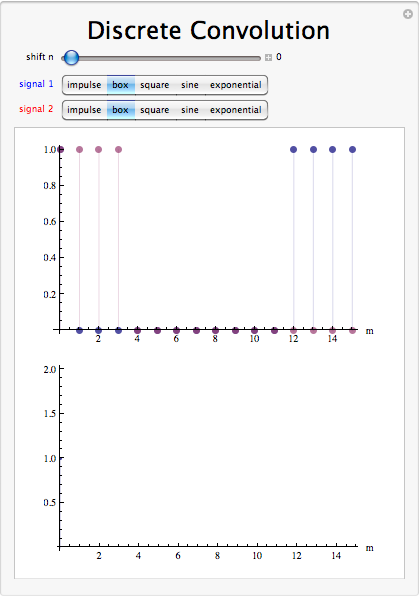9.5: Discrete Time Convolution and the DTFT
- Page ID
- 22897
Introduction
This module discusses convolution of discrete signals in the time and frequency domains.
The Discrete-Time Convolution
Discrete Time Fourier Transform
The DTFT transforms an infinite-length discrete signal in the time domain into an finite-length (or \(2 \pi\)-periodic) continuous signal in the frequency domain.
DTFT
\[X(\omega)=\sum_{n=-\infty}^{\infty} x(n) e^{-(j \omega n)} \nonumber \]
Inverse DTFT
\[x(n)=\frac{1}{2 \pi} \int_{0}^{2 \pi} X(\omega) e^{j \omega n} d \omega \nonumber \]
Demonstration

Convolution Sum
As mentioned above, the convolution sum provides a concise, mathematical way to express the output of an LTI system based on an arbitrary discrete-time input signal and the system's impulse response. The convolution sum is expressed as
\[y[n]=\sum_{k=-\infty}^{\infty} x[k] h[n-k] \nonumber \]
As with continuous-time, convolution is represented by the symbol \(*\), and can be written as
\[y[n]=x[n] * h[n] \nonumber \]
Convolution is commutative. For more information on the characteristics of convolution, read about the Properties of Convolution (Section 3.4).
Convolution Theorem
Let \(f\) and \(g\) be two functions with convolution \(f*g\). Let \(F\) be the Fourier transform operator. Then
\[F(f * g)=F(f) \cdot F(g) \nonumber \]
\[F(f \cdot g)=F(f) * F(g) \nonumber \]
By applying the inverse Fourier transform \(F^{−1}\), we can write:
\[f * g=F^{-1}(F(f) \cdot F(g)) \nonumber \]
Conclusion
The Fourier transform of a convolution is the pointwise product of Fourier transforms. In other words, convolution in one domain (e.g., time domain) corresponds to point-wise multiplication in the other domain (e.g., frequency domain).


